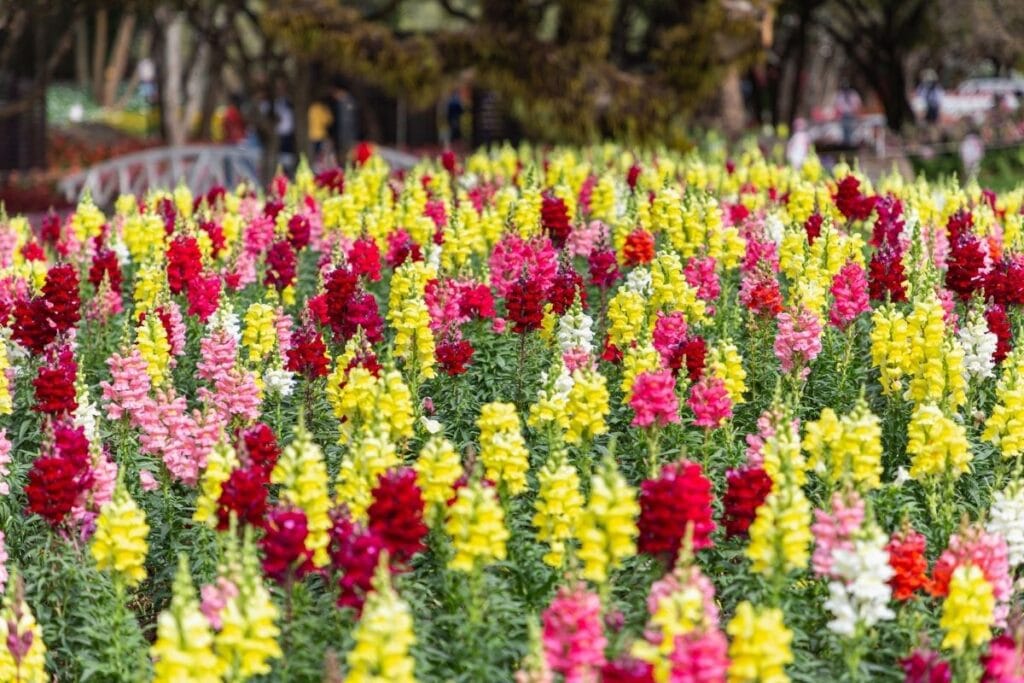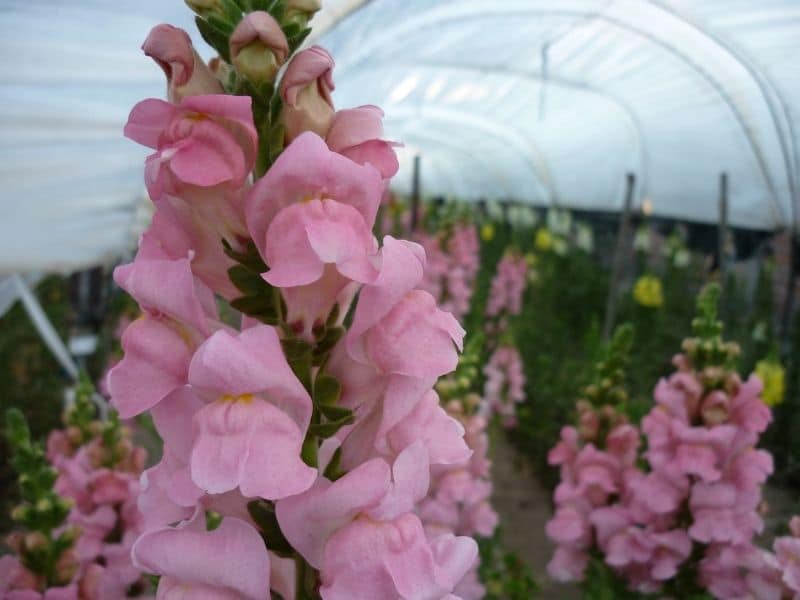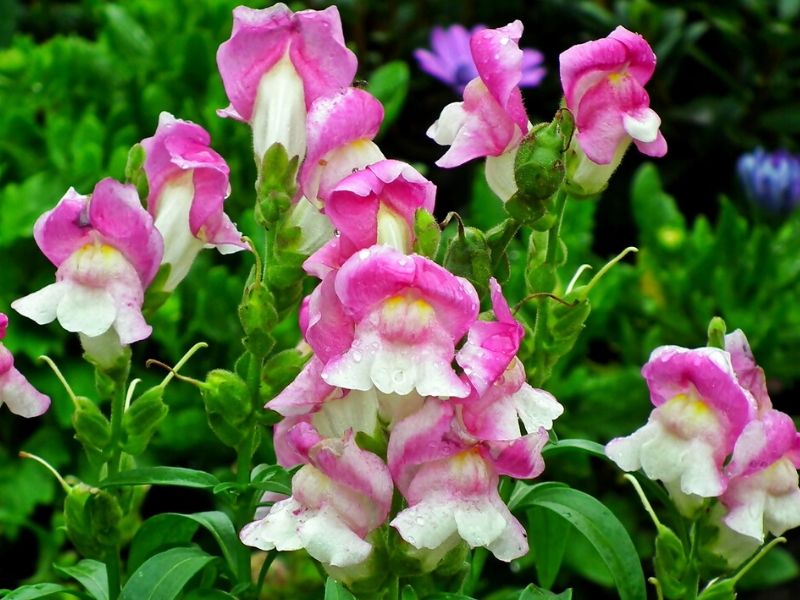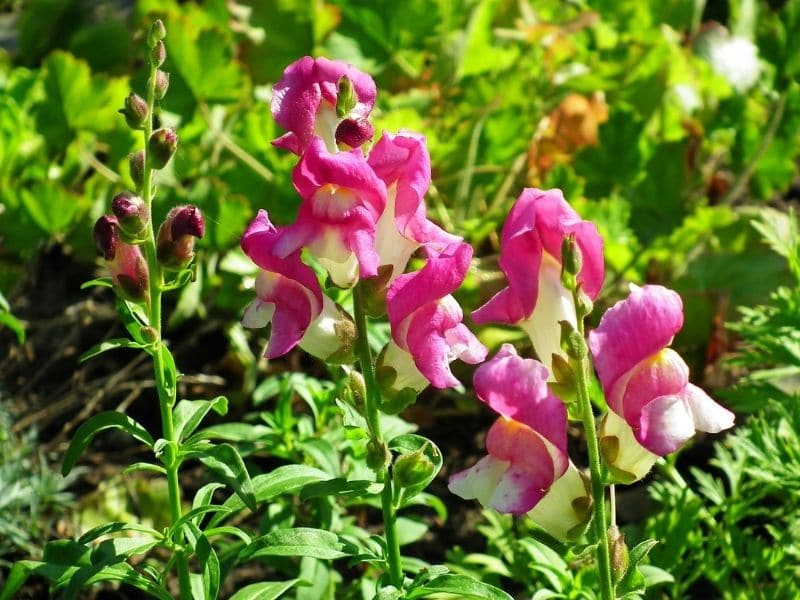The snapdragon is a beautiful flower and it is surprisingly easy to grow! The flowers come in a variety of colors including red, white, yellow, pink and purple.
It’s been said that the snapdragon was named after its ability to move quickly from side-to-side with its head “snapping” back and forth.
A great plant for beginners, snapdragons require little maintenance and can be used in all sorts of garden settings. They come in many different colors, shapes, and sizes so there is something for everyone!
This guide will cover the basics of growing a snapdragon flower from seed to finish with tips on how to care for them throughout their life cycle.
What Are Snapdragons?
Snapdragons are flowering plants that belong to the Antirrhinum genus of plants. Often referred to as dragon flowers (since the blossoms look just like the face of a dragon when squeezed!) These flowers are native to Europe, North Africa, and the United States.
These plants look wonderful when used in a border or as cut flowers. They are short-lived perennials that can survive brief periods of cool weather but are often grown as annuals in colder environments.
Widely cultivated in tropical and temperate zones alike, snapdragons look great in containers, raised beds, and border gardens. They can be found in just about any color, including red, pink, white, and more.

Types of Snapdragon Flowers
Snapdragons are tall plants that come in just about every color of the rainbow! Some of the most common types of snapdragons you might consider growing include:
‘Madame Butterfly’ Snapdragons
‘Madame Butterfly’ Snapdragons are a popular series known for their unique double-flowered form, resembling butterflies in flight.
These cultivars produce densely packed, fully double blooms with ruffled edges, creating a striking and intricate appearance. ‘Madame Butterfly’
Snapdragons come in a variety of colors, including shades of pink, purple, yellow, orange, and white, offering a vibrant and diverse palette for gardeners to choose from.
Aroma Series
The Aroma Series is a group of snapdragon cultivars that are highly prized by growers. They boast super-strong stems and massive quantities of blooms, with plants growing to nearly three feet in height.
The different colors available in this series include Peach Breeze, Magenta Mist, Fresh Lemon, French Vanilla, and Red Spice.
Candy Showers
Another group of snapdragon cultivars to consider growing is the Candy Showers group. These trailing snapdragons have sturdy stems and grow in a full, dense habit. They produce flowers in shades like red, yellow, orange, purple, white, and rose.
Flowers can spread up to eight inches wide, making them good choices for hanging baskets and other types of containers. Some can even be grown as ground covers!
Chantilly
Chantilly is a massive group of snapdragon flowers that produce hardy, vigorous blooms, and butterfly-shaped flowers. THese lightly-scented snapdragons easily reach more than three feet in height and look excellent when grown in bunches in the garden.
Some colors you might find include:
- Pink
- Velvet
- White
- Yellow
- Light Salmon
- Light Pink
- Deep Orange
- Cream Yellow
- Bronze
Floral Showers
Floral Showers snapdragons are prized for their dwarf properties as well as their heat-resistant nature. These grow to only about seven or eight inches in height with flowers that can be three inches wide!
The colors available for this variety include red and yellow, purple, and mix.
Frosted Flames
If you grow Frosted Flames snapdragons in your garden, trust us – it will look as though your flower beds are on fire! These snapdragons offer petals that are variegated in colors like cream, rose, red, pink, yellow, and multicolored. They grow dense, full blooms that are instant eye-catchers.
Liberty Classic Mix
Liberty Classic snapdragons are also quite large, growing up to 22 inches high. These are some of the easiest snapdragons to care for, available in colors like red, yellow, pink, lavender, and bronze. They make gorgeous vertical accents!
Royal Bride
Royal Bride is a snapdragon cultivar with strong spikes and deep green foliage. These flowers look wonderful in vases, garden beds, and borders – especially if you’re growing a garden of exclusively white flowers.
Of course, this list is by no means exhaustive and is only a small snapshot of all the snapdragon varieties at your disposal. There are even taller and trailing snapdragons available (as well as dwarf cultivars that rarely grow to more than eight inches high).

Growing Snapdragons
You can start growing snapdragon flowers earlier in the season than almost any other plant! These flowers can be planted in late winter since they can handle a frost, so start planting early for the best snapdragons bloom results.
You will want to plant your flowers in a full sun location with well-draining soil. Prior to planting, work some organic matter into the soil to help ensure adequate blooming. Add organic matter like compost, turning to a depth of eight inches. Level with a rake to remove any stones before you plant.
Snapdragons are not difficult to grow in the garden and you won’t be the only one to enjoy them! These plants are deer resistant but will attract plenty of other welcome visitors, such as butterflies, bees, and hummingbirds.

How to Plant Snapdragons
The snapdragon flower can be started from seed that is sown early in the winter indoors and transplanted outside – or they can be grown from potted plants.
If sowing seed indoors, do so about 12 weeks before the last frost. Although these plants can handle a light frost, starting your seeds so early will ensure that you have vibrant flowers for the first sign of spring!
Sow the snapdragon seeds thinly on the soil, pressing lightly into the seed starting mixture. Keep it moist at around 65 degrees. These plants prefer cooler temperatures so you should avoid using any kind of bottom heat.
Once your seedlings emerge (it will take around 8 to 14 days for them to do so), provide them with plenty of light on a sunny windowsill. You can also opt to grow your seedlings three or four inches beneath fluorescent plant lights (just turn them off for around eight hours per day).
After the plants have two sets of leaves, you can thin to one seedling per cell. Pinch the tops when the seedlings are three to four inches tall.
Before you plant your snapdragons out in the flower garden, be sure to harden them off. By accustoming young plants to the outdoor conditions – something you can do by putting the plants in a sheltered place outside for one week – it will help them get ready for “outdoor living.” put them outside for a few hours each day, gradually increasing the time spent outdoors until they can spend 24 hours out of the house.
When you plant transplants in your garden. Make sure they are about six to twelve inches apart. The planting hole should be large enough to accommodate the root ball of the plant. Water thoroughly after planting – a small puddle should form around the planting area.

Caring for Snapdragons
Ready to start growing your own snapdragons? Once your seeds or transplants are in the ground, you’ll just need to follow these tips for caring for snapdragons in your home garden.
Watering
Proper watering is essential when it comes to caring for snapdragons. Keep the plant moist for the first few weeks after planting. Once the plants are established, they require minimal watering except for in dry spells – you can water at a rate of about one inch per week when it does not rain.
When you water, do so at the base of the plant and try not to water overhead. Snapdragons, like many flowering plants, are prone to fungal diseases that can be spurred on by improper watering. Once your plants are established, allow the soil to dry at about an inch deep before you water again.
Not sure if your snapdragons are getting the water they need? Consider using a rain gauge. This will allow you to check if you need to add water.
Many snapdragon growers choose to use a drip irrigation system to deliver water at low pressure right at the soil level. Watering overhead with sprinklers can cause disease problems – if you do this, just do so early in the day so the foliage has time to dry off.
Weeding
Mulch is another important item to have on hand after planting your snapdragons. Apply a two-inch-thick layer of mulch around your snapdragons to help the soil retain moisture – and more importantly, to help keep weeds at bay.
You can use any kind of mulch you want, but some good options include wood chips, straw, and compost, all of which will add nutrients to the soil as they break down.
Even if you don’t use mulch, it’s essential that you find ways to keep weeds under control. Weeds will compete with your fragile young snapdragons for space, water, and nutrients – cultivate the soil often but be careful not to disturb small seedlings.
Fertilizing
Fertilizer isn’t necessary when growing snapdragon plant but you may wish to add some if you’d like to improve the appearance of your flowers.
Use fertilizer only after new growth appears. Keep granular fertilizers away from the crown of the plant to avoid the likelihood of burn injury. You should use a slow-release fertilizer diluted to half-strength – using a fertilizer that is too intense can lead to root rot.
Pests and Diseases
An easy way to prevent diseases of all kinds among your snapdragon plants is to remove plants after they are frost-killed each fall. That way, you won’t have to worry about pathogens overwintering in the soil.
One of the most common diseases that you may have to deal with when growing snapdragons is bacterial leaf spot. The first signs of this disease appear as tiny translucent spots with yellow edges. These spots slowly but surely get bigger, forming irregular circles with red centers.
This disease thrives in cool temperatures. To get rid of it, you’ll need to remove any infected plants and avoid overhead watering.
Another fungal disease to watch out for is damping off. This disease rears its ugly head primarily during the seed starting stages. The seedling will emerge, seemingly healthy, then suddenly die for no apparent reason.
This disease is caused by a fungus that is most active when there is too much moisture and when soil and air temperatures are high. It can also indicate an overabundance of nitrogen. To prevent damping off, avoid overfertilizing your seedlings and thin to prevent overcrowding.
As for pests, the biggest irritant you will need to watch out for is the aphid. Aphids are green, black, red, or peach and spread diseases as they feed on plant leaves. These creatures also leave a sticky substance, honeydew, behind that attracts ants.
Aphids can be blasted off your plants with a spray of water – or you can use an insecticidal soap or natural predators to get rid of them.
One more pest to be aware of is the leafminer. These insects bore into plant leaves, causing ugly, irregular lines. They don’t usually kill plants but can cause serious disfigurement that makes your snapdragons far less attractive.
Other Tips for Growing Snapdragons
Part of caring for your snapdragon plants also includes removing spent flowers. Although failing to deadhead your plant won’t kill it, it will stop the plant from producing any more luxurious blossoms for you to enjoy!
Although most people purchase and grow snapdragons as annuals, if you live in the right growing zone and provide the proper area, you may be able to grow snapdragons as perennials. Regardless, as your plants get taller, some larger varieties may need to be staked.
The snapdragon plant is one of many deer-resistant flowers so you won’t have to worry about these intruders munching on your plants. In fact, planting some snapdragons in the vegetable patch may help keep deer away from these areas, too! You can cut snapdragons and bring them inside for a showy arrangement on the countertop.
If you’re looking for a beautiful, fragrant addition to your garden that will thrive in the partial shade and attract pollinators like butterflies and bees alike, snapdragons are an excellent choice.
Hopefully, our guide to growing and caring for snapdragon plants gave you all of the tips and instructions necessary for growing these beauties from seedlings or transplants – but the best way to learn how to grow snapdragons? Try it for yourself! You’re sure to fall in love with these towering beauties.
FAQs
What is snapdragon flower used for?
Snapdragon flowers are commonly used in gardens and floral arrangements for their vibrant colors and unique shape. They add visual interest to landscapes, borders, and bouquets and are often grown for their ornamental value.
Why is it called snapdragon?
Snapdragon flowers are named for their unique structure that resembles a dragon’s head. When the sides of the flower are gently squeezed, the “dragon’s mouth” can be made to open and close like a snap, hence the name “snapdragon.”
How long do snapdragon flowers last?
Snapdragon flowers typically last for several weeks, depending on growing conditions and climate. Regular deadheading can prolong the flowering period by encouraging new blooms to develop.
Can you eat snapdragon flowers?
No, snapdragon flowers are not typically consumed, they are not considered toxic to humans. However, they are primarily grown for ornamental purposes, and their taste and texture are not particularly palatable.
Do snapdragons have a smell?
Snapdragon flowers do not have a strong scent, although some varieties may have a slight fragrance. The focus of snapdragon cultivation is primarily on their colorful blooms and unique shape rather than their scent.
For more flowers to grow, see our names of flowers list!
Up next: Snapdragon Flower Meaning and Symbolism
*image by khairil77&phanthit/depositphotos







